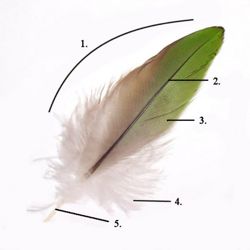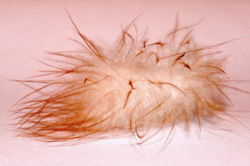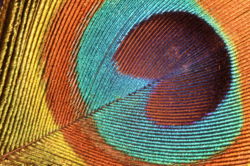Difference between revisions of "Feather - Anatomy & Physiology"
Fiorecastro (talk | contribs) |
|||
| (7 intermediate revisions by 4 users not shown) | |||
| Line 1: | Line 1: | ||
| − | {{ | + | {{OpenPagesTop}} |
| − | |||
| − | |||
| − | |||
| − | |||
| − | }} | ||
| − | |||
==Introduction== | ==Introduction== | ||
Feathers are one of the epidermal growths that form the distinctive outer covering, or '''plumage''' of birds. They are the outstanding characteristic that distinguishes the Class '''Aves''' from all other living groups. | Feathers are one of the epidermal growths that form the distinctive outer covering, or '''plumage''' of birds. They are the outstanding characteristic that distinguishes the Class '''Aves''' from all other living groups. | ||
| Line 17: | Line 11: | ||
'''Additional functions''' | '''Additional functions''' | ||
*Courtship displays | *Courtship displays | ||
| + | *Cleanliness | ||
*Defence | *Defence | ||
| − | Cryptic colouring (camouflage) | + | *Cryptic colouring (camouflage) |
| − | + | *Colour mimicking | |
| − | Colour mimicking | + | *Dominance/subdominance conflicts |
| − | + | *Sound production | |
| − | Dominance/subdominance conflicts | ||
| − | |||
*Aggressive territorial behaviour | *Aggressive territorial behaviour | ||
| Line 44: | Line 37: | ||
*'''Contour feathers''': these are the predominant feather covering the body. | *'''Contour feathers''': these are the predominant feather covering the body. | ||
*'''Coverts''': are small contour feathers of the wing and the tail. | *'''Coverts''': are small contour feathers of the wing and the tail. | ||
| − | *'''Remiges''': are large stiff feathers of the wing. | + | *'''Remiges''': are large stiff flight feathers of the wing. |
*'''Retrices''': are large stiff flight feathers of the tail. | *'''Retrices''': are large stiff flight feathers of the tail. | ||
| − | *'''Specialised adapted feathers''': include semiplumes, hypopnea, | + | *'''Specialised adapted feathers''': include semiplumes (enhance thermal isulation, enable courtship), hypopnea, filoplumes (hairless feathers than grow along down feathers and monitor the position of adjacent feathers) and bristles (stiff feathers with sensory and protective functions). |
| − | *'''Down feathers''': can be subcategorised into | + | *'''Down feathers''': help insulate the bird and contributes to buoyancy. They can be subcategorised into body, natal and powder down. Powder down are specialised down feathers that disintegrate and produce a powder (keratin) that is spread through the feathers during preening. They are found throughout the body among the down and contour feathers. |
==Physiology of the Feather== | ==Physiology of the Feather== | ||
| Line 117: | Line 110: | ||
'''Fret marks''' (stress lines) appear as clear breaks in the feather colour as a result of interruption in feather growth and malformation of the feather barbs. Nutritional, environmental, disease or drug stresses can result in the production of 'fret marks'. | '''Fret marks''' (stress lines) appear as clear breaks in the feather colour as a result of interruption in feather growth and malformation of the feather barbs. Nutritional, environmental, disease or drug stresses can result in the production of 'fret marks'. | ||
| − | = | + | {{Learning |
| − | + | |flashcards = [[Feather flashcards - Anatomy & Physiology|Feather Flashcards]] | |
| − | [[ | + | [[Avian Medicine Q&A 01]] |
| − | + | |OVAM = [http://www.onlineveterinaryanatomy.net/content/interactive-avian-anatomy-feather-0 Avian Interactive Anatomy - Feather 1]<br>[http://www.onlineveterinaryanatomy.net/content/interactive-avian-anatomy-feather-3 Avian Interactive Anatomy - Feather 2]<br>[http://www.onlineveterinaryanatomy.net/content/interactive-avian-anatomy-feather-2 Avian Interactive Anatomy - Feather 3]<br>[http://www.onlineveterinaryanatomy.net/content/interactive-avian-anatomy-feather-1 Avian Interactive Anatomy - Feather 4]<br>[http://www.onlineveterinaryanatomy.net/content/interactive-avian-anatomy-wing-0 Avian Interactive Anatomy - Wing 1]<br>[http://www.onlineveterinaryanatomy.net/content/interactive-avian-anatomy-wing Avian Interactive Anatomy - Wing 2] | |
| + | }} | ||
==Links== | ==Links== | ||
http://en.wikipedia.org/wiki/Feathers | http://en.wikipedia.org/wiki/Feathers | ||
| + | ==Webinars== | ||
| + | <rss max="10" highlight="none">https://www.thewebinarvet.com/internal-medicine/webinars/feed</rss> | ||
| − | + | [[Category:Integumentary System - Anatomy & Physiology]][[Category:Image Review]] | |
| − | [[Category:Integumentary System]] | ||
Latest revision as of 18:05, 7 December 2022
Introduction
Feathers are one of the epidermal growths that form the distinctive outer covering, or plumage of birds. They are the outstanding characteristic that distinguishes the Class Aves from all other living groups.
Structure & Function
Principal functions:
- Flight
- Insulation
- Waterproofing
Additional functions
- Courtship displays
- Cleanliness
- Defence
- Cryptic colouring (camouflage)
- Colour mimicking
- Dominance/subdominance conflicts
- Sound production
- Aggressive territorial behaviour
In most birds, the body is divided into areas that contain feather tracts, pterylae and areas that do not, apteriae. The location and the number of tracts varies between species. By originating from tracts rather than being randomly distributed, feathers can smoothly overlap and conform to the natural contours of the body. By laying feathers over apteriae, air can be trapped beneath, providing insulation.
The portions of the feather can be described as follows:
- Calamus: The short, hollow, tubular, unpigmented end of the mature feather inserted into the feather follicle and thus present below the skin level.
- Rachis: The long solid, tubular extension of the calamus above the skin. The rachis contains pith, which is composed of air-filled keratinised epithelial cells surrounded by a solid keratinised outer cortex.
- Shaft: The combination of the rachis and the calamus.
- Vane or Vexillum: The portion of the feather that extends to either side of the rachis and is composed of the barbs and their associated structures. The vane is either plumulaceous (soft and downy) or pennaceous (compact and closely knit) depending on the individual type of feather.
- Barbs: The series of branches fused to the rachis, constituting the major surface area of the feather. Barbs also have branches called barbules which have hooks that lock the barbs together.
Types of Feather
Feathers are characterised and categorised by the structure of the rachis, barbs and barbules. There are 10 types recognised.
- Contour feathers: these are the predominant feather covering the body.
- Coverts: are small contour feathers of the wing and the tail.
- Remiges: are large stiff flight feathers of the wing.
- Retrices: are large stiff flight feathers of the tail.
- Specialised adapted feathers: include semiplumes (enhance thermal isulation, enable courtship), hypopnea, filoplumes (hairless feathers than grow along down feathers and monitor the position of adjacent feathers) and bristles (stiff feathers with sensory and protective functions).
- Down feathers: help insulate the bird and contributes to buoyancy. They can be subcategorised into body, natal and powder down. Powder down are specialised down feathers that disintegrate and produce a powder (keratin) that is spread through the feathers during preening. They are found throughout the body among the down and contour feathers.
Physiology of the Feather
Feather growth
Feathers arise from feather follicles. These are formed by invaginations of the skin and closely fit the calamus. The feather follicle is analogous with the hair follicle in mammals. As in mammals, the follicle consists of epidermal and dermal cells and is lined with living and cornified epidermal cells. At the umbilicus of the calamus, the dermis carries a hump of pulp into the tip of the calamus. The follicular wall has an abundant supply of sensory nerve fibres, and the papillae, pulp and feather muscles are also well innervated. Smooth muscles at the base of the feather follicles help maintain body temperature by increasing or decreasing the elevation of the feathers from the skin. Herbst's corpuscles at the base of the feather follicles are believed to detect subtle ground vibrations and changes in air current.
Feather colour
Feather colour is determined by two factors:
- Biochromes:
Colour pigments that are deposited at the time of feather development. These can be naturally occurring, or synthetically produced. Black, brown and grey colours come from melanin, whereas carotenoids in the diet create red, orange and yellow and porphyrins synthesised by the bird form green, red and some browns.
- Structural properties:
These structural features of the feather can be inherent in the development of the feather. They can also be induced by materials that are placed on the feathers after development, that alter the absorption or reflection of light.
If a feather reflects all light, it appears white; if it absorbs all wavelengths, it appears black. The capacity of the barbs and barbules to scatter and reflect varying wavelengths of light causes an irridescent glow of the feathers. Blue colours are created by the barbs interacting to reflect blue light, while allowing other wavelengths of light to be absorbed by darker melanin granules. Green colours may be created by pigments, or more commonly, through a combination of blue and yellow pigments.
Colour mutations
These are of two basic types:
- The genetic ability or inability to absorb, manufacture or deposit colour pigments.
- An alteration in the feather structure (usually at barbule level) creating a different reflective or absorptive light pattern.
Mutations are often the two types in combination. However, similar colour changes can also be observed due to disease or malnutrition, especially deficiencies of essential amino acids and vitamins.
Some red colouration in the appendages of birds is caused by vascularisation and not pigment disposition. The combs and wattles on chickens and in some part, the mouth colouring of baby chicks, are examples.
Moult
Soft keratin structures undergo constant moult and replacement in a similar fashion to mammalian skin. Feathers moult by the growth of a NEW feather causing the shedding of an old one in a similar way to that of hairs of mammals.
Moulting patterns and periods vary with:
- Age
- Species
- Sex
- Time of year (including temperature and hours of light)
- Breeding patterns
- Nutrition
The moult may be:
- gradual - may last many months
- dramatic - over a few weeks
- continual - e.g. powder down
Proximal control of the moult is complex and influenced by circannual rhythms of changing photoperiod and temperature. Pineal gland - hypothalamic - pituitary and autonomic nervous system - endocrine pathways seem to operate. Hormonal influences identified include:
- Oestrogens
- Progestogens
- Thyroid hormones
- Catecholamines
- Prolactin
Ultimate control of the moult involves many factors, the most influencial being nutrition. Feathers can constitute in excess of 10% of the body mass of a bird and renewing this amount of tissue in a relatively short period of time places a high metabolic and nutritional demand on a bird.
- Protein
Protein, mainly in the form of keratin makes up approximately 90% of the dry matter content of feathers. Structurally, keratins contain a higher level of the sulphur-containing amino acids methionine and cysteine than normal body or egg protein.
There is no indication that (mal)nutrition has any proximal control over the onset of the moult as moult will proceed irrespective of the nutrtional status of the bird.
Inadequate nutrition pre- or peri-moult will result in the bird adjusting its moult by:
- delaying or interrupting the moult
- reducing the rate of feather production (to meet nutritive intake or reduce daily needs)
- sustaining the production at the cost of other body functions
- or a combination of the above
The result of these changes is either a protracted moult or poor quality feathers (pigmentation changes, structural defects to the barbs, 'thin' feathers).
Fret marks (stress lines) appear as clear breaks in the feather colour as a result of interruption in feather growth and malformation of the feather barbs. Nutritional, environmental, disease or drug stresses can result in the production of 'fret marks'.
| Feather - Anatomy & Physiology Learning Resources | |
|---|---|
 Test your knowledge using flashcard type questions |
Feather Flashcards |
Anatomy Museum Resources |
Avian Interactive Anatomy - Feather 1 Avian Interactive Anatomy - Feather 2 Avian Interactive Anatomy - Feather 3 Avian Interactive Anatomy - Feather 4 Avian Interactive Anatomy - Wing 1 Avian Interactive Anatomy - Wing 2 |
Links
http://en.wikipedia.org/wiki/Feathers
Webinars
Failed to load RSS feed from https://www.thewebinarvet.com/internal-medicine/webinars/feed: Error parsing XML for RSS


